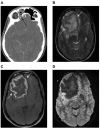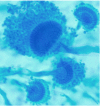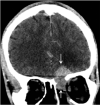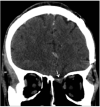Invasive aspergillosis of the central nervous system in immunocompetent patients in Saudi Arabia: Case series and review of the literature
- PMID: 34663711
- PMCID: PMC9037780
- DOI: 10.17712/nsj.2021.4.20210081
Invasive aspergillosis of the central nervous system in immunocompetent patients in Saudi Arabia: Case series and review of the literature
Abstract
Objective: Invasive aspergillosis of the central nervous system in immunocompetent patients is a rare disease. We present in this study three cases that were treated in our centre and reviewed the results of similar studies from Saudi Arabia.
Methods: We retrospectively reviewed all cases of invasive aspergillosis of the central nervous system (CNS) that were treated in our hospital in the last 10 years. We also reviewed the literature for any similar series published from Saudi Arabia.
Results: We had three cases treated in our centre and we also found three similar case series in the literature. Total number of cases, including our series was 28, age range from 17 to 66, 10 men and 18 women. The source of infection was nasal sinuses in all cases. Initial presentations were variable and included headache (80% of cases), proptosis or diplopia (50% of cases), seizures (20% of cases), cranial nerve palsies (18% of cases) and acute deterioration in level of consciousness (18% of cases). All patients underwent surgery followed by long course of antifungal treatment. Clinical outcome was reported as cured or no recurrence in 13 cases (47%).
Conclusions: Invasive aspergillosis of CNS is a rare disease in immunocompetent patients. Despite treatment prognosis remains unfavourable in many cases.
Copyright: © Neurosciences.
Figures






References
-
- Siddiqui AA, Shah AA, Bashir SH.. Craniocerebral aspergillosis of sinonasal origin in immunocompetent patients: clinical spectrum and outcome in 25 cases. Neurosurgery 2004; 55: 602–11; discussion 611-613. - PubMed
-
- Nadkarni T, Goel A.. Aspergilloma of the brain: an overview. J Postgrad Med 2005; 51: S37–S41. - PubMed
-
- Al-Bhlal LA. Fungal infection of the nasal cavity and paranasal sinuses: Review of 26 cases. Ann Saudi Med 1996; 16: 615–621. - PubMed
Publication types
MeSH terms
Substances
LinkOut - more resources
Full Text Sources
Medical
